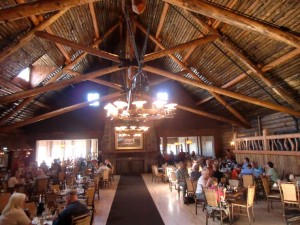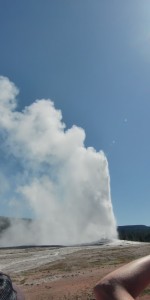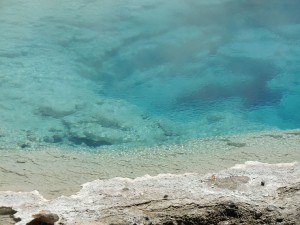THE BEST OF THE WEST – IN THE LAND OF THE GEYSERS (PART 1)
THE BEST OF THE WEST
This is the seventh in a series of articles about traveling the West by bus
IN THE LAND OF THE GEYSERS (PART 1)
By Charles N. Stevens
Photos by Dolores Seidman
A few clouds lean out of the southwest as we walk down the hill to the Lake House Café for a buffet breakfast. Strolling down through the quiet trees, the air nippy and fresh, is a
pleasant way to start the day. Patches of snow still linger on the ground beneath the trees, the shadows of the pines tracing patterns on their soiled iciness. The sun shimmers on Yellowstone Lake as chipmunks play among the trees, darting then stopping in their nervous, erratic way.
Leaving early, our bus heads for Old Faithful Geyser, great views of Yellowstone Lake and miles and miles of lodgepole pine forests passing by our windows. Sunshine and shadow flicker among the slim, straight trunks of the pines. The bus lumbers over the Continental Divide at 8,300 feet then on to the Old Faithful Inn. The inn is a majestic structure, its interior a maze of lodgepole pine wood stripped of its bark then polished to reveal its amber beauty. As we stand just inside, we look up at wooden beams, braces, stairways and balcony railings. Rising up through it all, over a yawning fireplace, is a huge rhyolite rock chimney reaching up through the ceiling at four or five stories in height. Built in 1904, it is the largest log construction hotel in the world.
Outside, steam wisps from the flat cone of Old Faithful Geyser, the wind playing with it, pushing it in all directions. I still have time before Old Faithful puts on its display, so I use it to quickly explore some of the highlights of the Upper Geyser Basin. The basin is a bare, chalky slope veined with rust-colored rock. Rivulets of hot water from the geysers coalesce to flow into the Fire Hole River, the steam rising from it drifting in the lazy wind currents. I gaze at the Chinese Spring, a small crater of boiling, bubbling water with steam rolling from its surface. Where the water spills over towards the river, it leaves reddish streaks on the white stone. The crater roils furiously at times then subsides, its steam smelling of sulfur, its sound like a boiling pot of water on a stove. A larger opening nearby continuously gurgles.
Back at the Old Faithful viewing area, people sit on benches curving around Old Faithful’s vent, anticipating the eruption. The low babble of voices and the guttural squawk of a raven are the only sounds. Steam rises gently out of the white mound, drifting to the west. All eyes are focused on the vent. Although its time of eruption varies throughout the year rangers can predict it down to the minute, the times being posted at the inn. Gradually it begins to come to life with more steam and blurbs of hot water. Then, with a low thunderous roar it erupts, launching jets of super-hot water in a violent plume of steam over one hundred feet high. Hundreds of cameras capture the phenomenon as everyone gasps with glee and wonder. As the water falls back, it clatters and splashes on the cone. Its “fit” over, it diminishes to just a wisp of steam, and the excited crowd gradually turns away. Seeing it blow is awesome, an experience everyone should see at least once in a lifetime.
On the bus again, we travel a short distance to the Lower Geyser Basin. It is a desolate area of white earth with a graveyard of dead, bleached trees standing in brackish water. Most interesting here are the Fountain Paint Pots where steam slowly bubbles up through thick gray “mud”, the large bubbles collapsing then throwing up bits of themselves. It’s a slow dance of bubbles, fascinating to watch. One excited little boy looking at them says, “plop, plop, plop,” a good description of the sounds the popping bubbles.
We continue walking through the area of small geysers and fumaroles, using a wooden walkway. We stop at a large blue, bubbling pool oozing water. Where the water flows, the white rock is stained with rusty-orange streaks caused by heat-loving bacteria. The water is so clear in the pool that we can peer down into its depth, perhaps thirty feet. It’s a wonder world down there, the rough ghostly white sides of the crater bathed in ethereal blue water.
Moving on through the bleak volcanic landscape, we’re conscious of the mammoth eruption that created the vast caldera that is Yellowstone Park, an explosion that must have altered the climate of the earth for a time. Today we walk through the last vestiges of that event, gazing at the steam vents, geysers and turbulent pools, inhaling the hydrogen sulfide odor of the primitive earth.
Leaving the geysers behind, we drive down the road, paralleling the rapids of the Firehole River. A small herd of buffalo kneels in the grass of a green meadow, apparently tired of walking and grazing. Two very shaggy ones stand near the road, oblivious to the constant stream of cars. It’s comforting to know that these imposing animals still exist, that at least in our imagination we can see them roaming the prairies again in great numbers. We pause briefly along the Gibbon River to look at Gibbon Falls, a roaring cascade of water. In many places we spot charred lodgepole pine trunks that had fallen to the ground, victims of the 1988 fire. They are left in place, as they would have been in a natural event, letting nature return their minerals to the earth.
We’re on our way to Mammoth Hot Springs, only a few miles ahead, where we’ll relax and find a bite to eat.

The Old Faithful Inn, built in 1904, is the largest wooden hotel in existence and a wonder to see.

Old Faithful erupted right on time, sending a plume of water and steam over 100 feet high.

This deep, incredibly blue pool in the lower geyser basin oozes boiling water.

The lower geyser basin is active with small geysers, mud pots and steaming pools.
MONTEREY PARK AUTHOR PUBLISHES 3RD BOOK ABOUT HIS EXPERIENCES IN WORLD WAR II- BACK FROM COMBAT
Charles “Norm” Stevens, a 40 year resident of Monterey Park and World War II Veteran has recently published the 3rd in his series about his experiences in WW II, Back from Combat: A WWII Bombardier Faces His Military Future. This book details the time from when he returned from combat in England where he flew 34 missions over Germany and France until the end of the war. Faced with large numbers of returning combat vets, and not knowing how long the war would continue, the military had to plan for their future. His options were whether to return to combat, become an instructor in the U.S., or receive new training that he would use in the Pacific. The book concludes with the end of the war with an Afterward that includes an update on the B-l7’s still flying in the U.S., as well as present day accounts pertaining to the war.
Stevens is the author of two previous books about his experiences:
An Innocent at Polebrook: A Memoir of an 8th Air Force Bombardier (Story of his 34 bombing missions from his base at Polebrook, England over Germany and France)
The Innocent Cadet: Becoming A World War II Bombardier (A prequel to the first, telling of his training in the U.S. before going overseas into combat.)
He is known to the readers of The Citizen’s Voice as the author of Travel Log Articles including “From Paris to Normandy on the Seine”, “Exploring New York” and “In Search of Snow.” He is retired, having taught for 32 years, primarily in the Montebello Unified School District.
Those interested in purchasing an autographed copy of any of his books, may contact the author at 323-721-8230 or Normstevens24@gmail.com.



